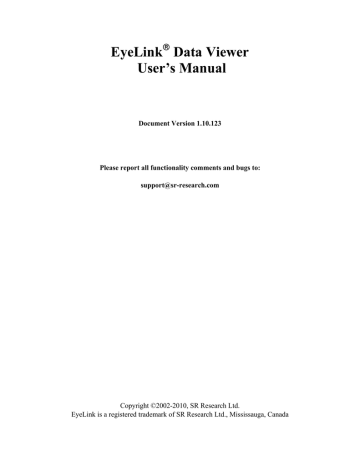
advertisement

saccade end point and start point are also adjusted so that the saccade positions are kept consistent with fixation positions.
1.5 Interest Periods and Reaction Time Definition
For each trial, the user may selectively view and perform analysis on data within a specific period of time within a trial (Interest Period). The EyeLink Data Viewer allows the user to create interest periods based on messages and button events. The created interest periods are added to the interest period list. The user can navigate between different interest periods by selecting the desired interest period from the list. For each interest period, only those events falling within that period are shown in the spatial overlay, temporal graph views, and in the event list of the inspector window. In addition, only those events and data within the selected interest period (custom-defined interest period, or the default – “Full Trial Period”) are exported to the output file.
One important variant of the interest period is the reaction-time period. Reaction Time
Definitions (RTD) can be created and applied to all trials loaded into an EyeLink Data
Viewer session. Each RTD can have a set of trial condition variables that must be matched for the RTD to be applied to a given trial. The message event to use as the start time for the reaction time can be defined. Each RTD can have a fixation, saccade, button, or message event as the ending event for the reaction time calculation. Depending on the event type selected for the reaction time end event, a set of event properties can be specified to determine which event should be used within each trial. A number of RTDs can be created for a given Data Viewer session, allowing multiple reaction time conditions to be specified. Each trial will only be matched to at most one RTD.
1.6 Data Output and Analysis
Both Spatial Overlay and Temporal Graph trial views can be saved as JPEG images for illustrative purposes.
A series of output reports can be run for a Data Viewer session.
The Fixation Output Report generates one row for each visible fixation within the Data
Viewer. A set of output variables can be selected, with each variable output as a column in the report. Fixation report variables include start and end time, duration, average position, interest area identifier, etc. A set of relative variables is also available, including the previous and next fixations position, angle, distance, and direction.
The Saccade Output Report generates one row for each visible saccade within the Data
Viewer. A set of output variables can be selected, with each variable output as a column in the report. Saccade output report variables include start and end time, start and end position, amplitude, angle, direction, average and peak velocity, etc. A set of relative variables is also available, including the previous and next saccades start and end position, etc.
EyeLink Data Viewer
©2002-2010 SR Research Ltd.
3
advertisement
* Your assessment is very important for improving the workof artificial intelligence, which forms the content of this project
Related manuals
advertisement
Table of contents
- 8 Introduction
- 8 Data Visualization
- 9 Event Selection
- 9 Interest Area Definition
- 9 Event Filtering
- 10 Interest Periods and Reaction Time Definition
- 10 Data Output and Analysis
- 11 Experiment Integration
- 12 Installation
- 12 System Requirements
- 12 Setup
- 12 For Standard Installation (applicable to most users)
- 13 For Installation using Network Licensing
- 14 Working with Files
- 14 Creating a Data Viewing Session (DVS)
- 14 Saving a Viewing Session
- 14 Opening an Existing Viewing Session
- 15 Saving an Existing Viewing Session to a Different File
- 15 Importing an EyeLink Data File
- 17 Data Viewer Windows
- 17 Inspector Window
- 17 Data Tab
- 19 Data Tree Hierarchy
- 19 Trial Grouping
- 20 Trial Summary
- 21 Interest Area Templates
- 22 Custom Interest Area Set/Empty Interest Area Set
- 22 Preferences Tab
- 22 Trial View Window
- 22 Selecting Data Elements to Display
- 23 Cloning a Trial View
- 23 Tiling/Cascading Windows
- 24 Spatial Overlay Trial View
- 26 Temporal Graph Trial View
- 26 Viewing Sample and Target Data
- 28 Zooming Operations
- 28 Animation View
- 31 Working with Events, Samples, and Interest Areas
- 31 Common Operations
- 32 Selecting Events
- 32 Deleting Events
- 32 Fixations
- 35 Selecting Fixations
- 35 Merging Fixations
- 35 Drift Correcting Fixations